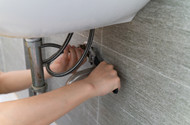Silicone Sealant for Plumbing: What You Need to Know
Jun 26th 2024
Whether you are installing a new shower drain or a kitchen sink, the primary concern of any plumber is ensuring a clean, watertight seal. While many plumbing professionals may swear by plumber's putty for any problem area, there may be a better option for many projects. This option is silicone sealant — one of the best sealants you can find today.
Today, we'll explore where and when silicone sealant can be best used in plumbing and why it is a great sealing candidate.
What Is Silicone Plumbing Sealant?
Silicone sealant is one of the most flexible, durable, and water-resistant types of sealant. It is also extremely temperature-resistant — making it ideal for plumbing applications. Many plumbers have found success using this sealant for their projects, and it also has many uses as a sealant outside of plumbing.
But if you are unfamiliar with silicone sealant, keep reading to learn a little more about how to apply it and when to use it before jumping right into a new product.
How to Apply Plumbing Silicone Sealant
Using a silicone sealant is a pretty straightforward process. However, to ensure you get a watertight and durable seal, you need to make sure you are working with the material correctly.
Luckily, you only need to follow a few simple steps to apply your silicone sealant.
Step 1. Clean the Target Surface
Wipe down and dry the area you are intending to seal. This will ensure you have a strong bond without any dust or dirt lingering on the surface.
Step 2. Prepare Your Tools
Silicone sealant application is often easiest using a caulking gun. This allows you to apply more consistent pressure, resulting in a more even bead of sealant along the seam you are sealing. To begin sealing, you must cut the tip of the silicone sealant cartridge and insert it into the caulking gun.
Step 3. Apply the Silicone
To apply the silicone, simply pull the trigger of the caulking gun. Slowly run the nozzle across the seam you wish to seal to create a bead of silicone. Ensure that you work on small areas at a time so that you have time to tool the silicone sealant before it begins curing for a clean finish.
Step 4. Allow the Sealant to Cure
All you need for this step is some patience. After applying the silicone, you must allow it to cure fully. This allows the sealant to reach full bond strength — after which your seal is ready for anything you or your client will throw at it.
The exact curing time will depend on the particular silicone sealant. Some take days to cure, while others only take 24 hours. Your sealant will list its cure time in the instructions.
Choosing the Right Product for Your Plumbing Project
Is silicone sealant truly the best solution for the project you are working on? In reality, while silicone sealant can be an excellent product for plumbing jobs, there are some situations where you may want to consider opting for some good old plumber’s putty instead.
Here are some of the benefits of silicone sealant and plumber’s putty and why either one might be the right choice for your project.
Silicone Sealant
As mentioned above, silicone sealant is extremely waterproof, incredibly durable, and temperature-resistant. This makes it a great option for any location often exposed to water or moisture. Additionally, because of its temperature resistance, it can withstand very hot and cold temperatures without cracking or getting brittle.
Situations you may want to opt for silicone sealant include:
- Sealing around pipes that have significant temperature fluctuations.
- Sealing areas constantly exposed to moisture — like bathtubs or kitchen sinks.
- Outdoor sealing projects where it needs to be weather-resistant.
- Sealing projects where you require a clean and aesthetically pleasing finish.
Plumber’s Putty
Plumber’s putty is an excellent choice for areas that require water resistance but not waterproofing. Plumber’s putty can be good for areas that require future adjustment as it is easier to manipulate and remove.
Plumber’s putty is not ideal for locations where it will face direct water pressure or where you need a completely waterproof seal.
Situations you may want to opt for plumber’s putty include:
- Areas where seals may need to be moved or adjusted
- When a fixture needs to be used immediately (putty has no curing time)
- Under drains or faucets
- Non-porous surfaces that need some water resistance
Remember to Always Opt for Quality Over Convenience!
No matter which product you use, ensuring that you are using a high-quality option is the key to creating a long-lasting and professional result.
While it may be more convenient to simply choose whatever brand and type of product you can find at your favorite local hardware store or depot, in many cases, this may not be the best quality option for your project. Using a sub-par product could lead to unexpected leaks that may have your clients calling you back with questions and ultimately result in losing future business with them.
Let Silicone Depot help you avoid these unhappy callbacks by supplying you with the perfect high-quality silicone sealant for your next plumbing project!

